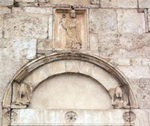

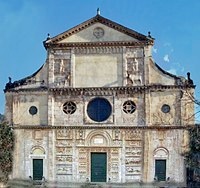
The magnificent facade is almost the only surviving element of the 12th century building. It is divided into three horizontal orders under a tympanum:
-
✴The central space of the top order, which is empty, was probably intended to house a mosaic. The reliefs to the sides of it each depict a censing angel with a calf standing sideways below.
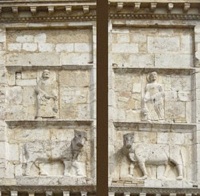
-
✴The middle order contains the remains of five rose windows. The central one has been destroyed, although its square surrounding panel with symbols of the Evangelists at the corners survives. The two outer ones have also been destroyed.
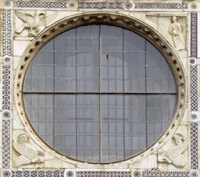
The bottom order contains the central portal and two side doors, and is distinguished by a series of interesting reliefs in its central section.
Facade Reliefs (12th or early 13th century)
The central part of the lower order has four components:
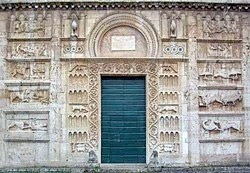
-
✴The space above the central portal contains a circular frame that might have come from the central rose window above. Two peacocks carved in high relief stand to the sides, above mosaic friezes.
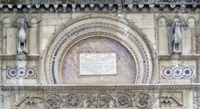
-
✴The circular frame contains an inscription that reproduces the (almost certainly inaccurate) information from the Leggendario di San Felice di Narco, which insists that St Brictius or Bishop John the Syrian founded the church early in the 4th century and that it was the original cathedral of Spoleto. It also adds, perhaps more reliably, that a number of later bishops were buried here, including another John (492-7), Laurence (552-63) and Peter (ca. 563). However, it mentions neither Bishops Achilles nor Bishop Amasius! [When was the inscription made and when was it placed here ??]
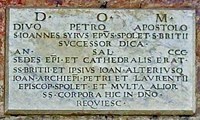
-
✴The panels to the sides contain a series of interesting reliefs:
-
•the two to the left contrast the posthumous fates of a righteous man (above) and of a sinner; and

-
•the two to the right depict Christ washing of Peter's feet (above) and the calling of Peter and Andrew on the Sea of Galilee.
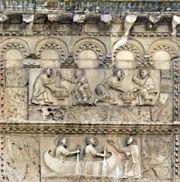
-
✴The panels that flank the central portal seem to be later than the others. Each of them contains figurative reliefs with elaborate arcades between them:
-
•the figurative relief at the top depicts a peacock (the symbol of eternal life) pecking grapes;

-
•the relief in the middle depicts a grazing cow; and
-
•the relief at the bottom depicts a man driving a yoke of oxen, while his dog jumps up in front.
-
✴Each of the outer panels in this order depicts three scenes of depicting birds and animals. (A correspondent recently suggested to me that the middle panel, which depicts a wolf and a sheep, is a representation of a fable about a wolf that a monk was teaching to read (hence the student hood and the tablet under his paws). However, all the wolf can think about is the sheep that is clearly distracting him (see, for example, http://iconics.cehd.umn.edu/Wolf/Lecture/default.html. My kcorrespondent suggested that the other panels might well have depicted other fables that are now lost).
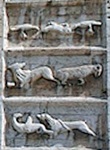
The side portals are less elaborately carved:
-
✴The relief over the left portal depicts St Michael slaying a dragon.
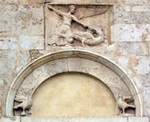
-
✴The relief over the right portal depicts a bishop, perhaps Bishop Achilles.
